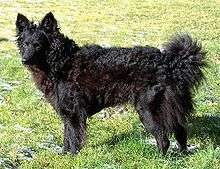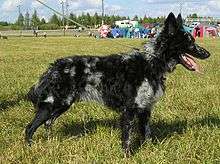Mudi
 A black Mudi | |||||||||||||||||||||||||
| Other names |
Hungarian Mudi Canis Ovilis Fenyesi | ||||||||||||||||||||||||
|---|---|---|---|---|---|---|---|---|---|---|---|---|---|---|---|---|---|---|---|---|---|---|---|---|---|
| Origin | Hungary | ||||||||||||||||||||||||
| |||||||||||||||||||||||||
| Domestic dog (Canis lupus familiaris) | |||||||||||||||||||||||||
The Mudi (in Hungarian, the plural form of mudi is mudik) is a herding dog breed from Hungary. It is closely related to the Puli and Pumi, from which it was separated in the 1930s. Today, the Mudi is bred for work, sport, companionship, and show. They continue to be used in herding, as well as participating in a variety of dog sports.
Description
Appearance
Mudi usually weigh 18 to 29 pounds (8.2 to 13.2 kg) and stand 15 to 19 inches (38 to 48 cm) high at the withers. The coat is medium wavy or curly, with short hair on the face and legs.[1] The accepted colors are black (fekete), brown (barna), white (fehér), Fawn (fakó), Ash (hamvas), and Cifra (marbling of black and gray) Mudis are born with various lengths of tails from bobtails to long full length tails. Dogs born with short or natural bobtail will be indicated on the FCI pedigree as docking is prohibited.
Temperament
The Mudi is a versatile farm dog that can hunt, exterminate rodents, and act as a capable herding dog and flock guardian. They are great for alerting and protecting their home and family. They have a high pitched bark and can be very loud and barky. There are 3 herding dogs native to Hungary the Puli, Pumi and Mudi, having similar characteristics. The mudi is a clever, keen, active, dog very very attached to its owner and family. They learn quick both good things and bad. The Mudi may be aloof with strangers and early socialization is recommended.
Exercise and activities
The Mudi is a very active breed. They need to be taken on a daily, long, brisk walk or jog. In addition, they will benefit from a large safe area where they can run free. They need a lot of running and other exercises to be in good condition. They love to play and will excel in all kinds of dog sports such as Frisbee. The Mudi can compete in dog agility trials, obedience, Rally obedience, Schutzhund, showmanship, flyball, tracking, and herding events. Herding instincts and trainability can be measured at noncompetitive herding tests. Mudi that exhibit basic herding instincts can be trained to compete in herding trials.[2]

Health problems
This is a fairly healthy breed, although some cases of hip dysplasia have occurred, but not many.
Living conditions
The Mudi can live in an apartment if it is sufficiently exercised; however, they need space to run and play and would do better if not kept in one. They are moderately active indoors and will do best with at least a large yard. This breed can live outdoors.
Life expectancy
About 13–14 years. Although, two Mudis in Canada lived to 17.5 years of age.
Grooming
The Mudi is easy to groom. An occasional combing and brushing to remove dead hair is all it needs. This breed is an average shedder.
References
- ↑ "Mudi - Royal Canin". Royal Canin. Retrieved 25 September 2015.
- ↑ Hartnagle-Taylor, Jeanne Joy; Taylor, Ty (2010). Stockdog Savvy. Alpine Publications. ISBN 978-1-57779-106-5.
External links
| Wikimedia Commons has media related to Mudi. |
- Mudi Association of Canada
- http://en.mimi.hu/dog/mudi.html
- American Mudi Association
- Mudi Club of America